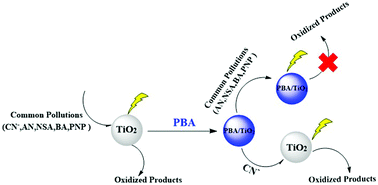Indicator/catalyst displacement assay: design of a latent catalyst for the selective detection and degradation of cyanide by Prussian blue analog-modified TiO2 nanoparticles†
Abstract
Prussian blue bimetallic analog (PBA)-modified TiO2 particles (NP1–3) were explored as a new generation of latent catalytic materials for the simultaneous detection and removal of cyanide using the indicator/catalytic displacement approach (ICDA). These PBAs not only act as ‘colored coats’ but also quench the oxidative degradation properties of TiO2 by facilitating the recombination of its electrons and holes. The obtained results revealed that among common organic/inorganic pollutants (e.g., cyanide, aniline, 1,5-naphthalenedisulfonic acid, benzoic acid, and 4-nitrophenol), only CN− could selectively induce a colorimetric response and the photocatalytic oxidative degradation of TiO2, while analytes bearing amine, sulfate, carboxylate, and phenol functionalities did not induce any response. These functional materials were also found to be applicable in real water bodies.



 Please wait while we load your content...
Please wait while we load your content...